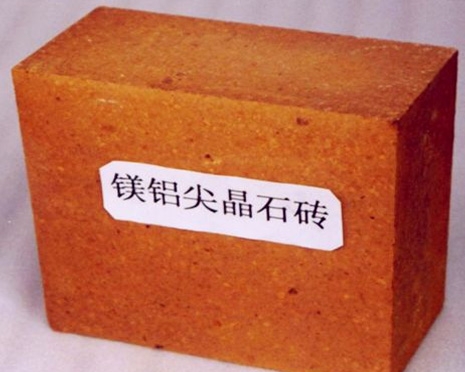- 29
- Sep
Magnesia alumina spinel brick
Magnesia alumina spinel brick

Magnesia alumina spinel bricks use primary brick magnesia and sintered magnesia alumina spinel sand with a C/S ratio of 0.4 as raw materials, with a critical particle size of 3mm. The magnesia particle size adopts 3~1mm large particles, <1mm medium particles and <0.088mm fine powder as three-level ingredients. Use sulfite pulp waste liquid as binding agent, mix with wet mill, and shape by 300t friction brick press. After the green body is dried, it is fired at 1560~1590°C. The weak oxidizing atmosphere should be controlled during the firing process.
The high-temperature mechanical properties and thermal shock stability of periclase-spinel bricks are better than those of ordinary magnesia alumina bricks. The compressive strength at room temperature is 70-100MPa, and the thermal shock stability (1000℃, water cooling) is 14-19 times. The periclase-spinel bricks can be used in the high temperature zone of active lime rotary kilns and cement rotary kilns.
my country’s magnesium-aluminum spinel adopts two production processes: sintering and fusion. The raw materials are mainly magnesite and industrial alumina powder or bauxite. According to the different indicators of magnesia and alumina, magnesia-rich spinel and aluminum-rich spinel are classified and applied in different fields.
1. According to the production process or method: sintered magnesium aluminum spinel (sintered spinel) and fused aluminum magnesium spinel (fused spinel).
2. According to the production raw materials, it can be divided into: bauxite-based magnesia-aluminum spinel and alumina-based magnesia-aluminum spinel. (Sintering or electrofusion)
3. According to content and performance, it is divided into: magnesium-rich spinel, aluminum-rich spinel and active spinel.
Magnesia alumina spinel brick is also called periclase-spinel brick, which is made of high-purity fused magnesia or high-purity two-step calcined magnesia and high-purity pre-synthesized magnesia-aluminum spinel as the main raw materials, using precise ingredients ﹑High-pressure forming and high-temperature firing production process. Compared with magnesia-chromium bricks, this magnesia-aluminum composite brick not only eliminates the harm of hexavalent chromium, but also has good corrosion resistance, oxidation-reduction resistance, heat resistance and high temperature volume stability. It is a large and medium-sized cement The most suitable chromium-free refractory material for the transition zone of rotary kiln. It has also been used in high-temperature equipment such as lime kilns, glass kilns, and out-of-furnace refining equipment, and has also achieved good results.
The physical and chemical indexes of the produced magnesium-aluminum spinel bricks are: MgO 82.90%, Al2O3 13.76%, SiO2 1.60%, Fe2O3 0.80%, apparent porosity 16.68%, bulk density 2.97g/cm3, normal temperature compressive strength 54.4MPa, 1400 ℃ flexural strength 6.0MPa.
Magnesium-aluminum spinel bricks have been successfully used in the transition zone of cement rotary kilns, but they are prone to structural embrittlement and structural spalling when used in the firing zone, difficult to hang on the kiln skin, and have poor resistance to alkali steam and cement clinker liquid phase permeability. And the poor ability to resist the mechanical stress caused by the deformation of the kiln body limits the application in the firing zone. For this reason, researchers have developed modified magnesia-aluminum spinel bricks suitable for the firing zone of cement rotary kilns. During firing and use, part of Fe2+ in the periclase-spinel refractory structure is oxidized to Fe3+. Subsequently, a part of Fe2+ and Fe3+ in the iron-aluminum spinel diffuses into the periclase matrix to form MgOss. At the same time, some Mg2+ in the matrix also diffuses into the iron-aluminum spinel particles, and reacts with the remaining Al2O3 from the decomposition of the iron-aluminum spinel to form magnesium-aluminum spinel. This series of reactions is accompanied by volume expansion, leading to the formation of microcracks. To
The iron-aluminum spinel bricks have good kiln-hanging properties and thermal shock resistance. Among them, the reason why the iron aluminum spinel hangs well on the kiln skin is similar to that of the mafic-iron spinel brick. It is also due to the action of the CaO in the cement clinker and the solid-dissolved Fe2O3 in the periclase to form crystals that can wet the periclase. , Calcium ferrite that bonds clinker and firebrick together. The reason for the good thermal shock resistance is the formation of microcracks.
In the MgO-Al2O3 system, the solid solution amount of Al2O3 in periclase at 1600°C is about 0; the solid solution amount at 1800°C is only 5%, which is much smaller than Cr2O3. In the MgO-Al2O3 system, the only binary compound is magnesium aluminum spinel. The melting point of magnesium aluminum spinel is as high as 2135℃, and the lowest eutectic temperature of MgO-MA is also 2050℃. Magnesium-aluminum spinel is a natural mineral, which is commonly found in bleaching sand deposits, so it has good chemical stability to natural materials.
The modulus of elasticity is small, magnesia alumina brick (0.12~0.228)×105 MPa, while magnesia brick is (0.6~5)×105MPa; MA can transfer MF from periclase, and can sweep FeO. The reaction is as follows: FeO+MgO • AI2O3→MgO+FeAl2O4, FeO+MgO→(Mg • Fe)O, MA absorbs Fe2O3 and expands slightly and has a high melting point. Spinel has a melting point of 2135°C, and its initial melting temperature with periclase is higher than 1995°C. The combination of the two will improve the bonding performance of magnesia bricks. The load softening temperature is high, but spinel formation is accompanied by volume expansion, and the aggregation and recrystallization ability is weak, so a higher firing temperature is required. Excellent thermal shock resistance. high strength. Strong erosion resistance.
